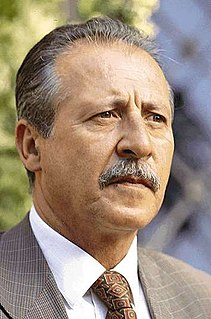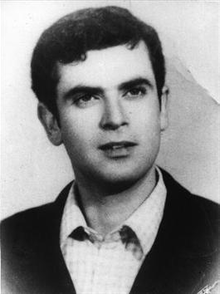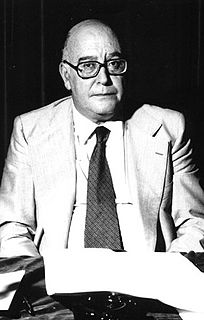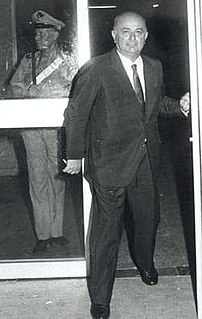Related Research Articles

Giovanni Falcone was an Italian judge and prosecuting magistrate. From his office in the Palace of Justice in Palermo, Sicily, he spent most of his professional life trying to overthrow the power of the Sicilian Mafia. After a long and distinguished career, culminating in the Maxi Trial in 1986–1987, on 23 May 1992, Falcone was assassinated by the Corleonesi Mafia in the Capaci bombing, on the A29 motorway near the town of Capaci.

Paolo Borsellino was an Italian judge and prosecuting magistrate. From his office in the Palace of Justice in Palermo, Sicily, he spent most of his professional life trying to overthrow the power of the Sicilian Mafia. After a long and distinguished career, culminating in the Maxi Trial in 1986–1987, on 19 July 1992, Borsellino was killed by a car bomb in Via D'Amelio, near his mother's house in Palermo.

Salvatore Achille Ettore Lima was an Italian politician from Sicily who was associated with, and murdered by, the Sicilian Mafia. He is often just referred to as Salvo Lima.

Stefano Bontade was a powerful member of the Sicilian Mafia. His actual surname was Bontate. He was the boss of the Santa Maria di Gesù Family in Palermo. He was also known as the Principe di Villagrazia − the area of Palermo he controlled − and Il Falco. He had links with several powerful politicians in Sicily, and with prime minister Giulio Andreotti. In 1981 he was killed by the rival faction within Cosa Nostra, the Corleonesi. His death sparked a brutal Mafia War that left several hundred mafiosi dead.

The Maxi Trial was a criminal trial against the Sicilian Mafia that took place in Palermo, Sicily. The trial lasted from 10 February 1986 to 30 January 1992, and was held in a bunker-style courthouse specially constructed for this purpose inside the walls of the Ucciardone prison.
The Stidda is a Mafia-type criminal organization centered in the central-southern part of Sicily in Italy. Members are known as stiddari or stiddaroli. It is most active in the rural parts of southern Sicily and is partially a rival to Cosa Nostra. Some members have a star tattooed on their bodies.

Michele Greco was a member of the Sicilian Mafia and a convicted murderer. Greco died in prison while serving multiple life sentences. His nickname was Il Papa due to his ability to mediate between different Mafia families. Greco was the head of the Sicilian Mafia Commission.

Leonardo Vitale was a member of the Sicilian Mafia who was one of the first to become an informant, or pentito, although originally his confessions were not taken seriously. Vitale was a "man of honour" or member of the Altarello di Baida cosca or family, Altarello being a small village just outside Palermo.

Salvatore Contorno, called Totuccio, is a former member of the Sicilian Mafia who turned into a state witness (pentito) against Cosa Nostra in October 1984, following the example of Tommaso Buscetta. He gave detailed accounts of the inner-workings of the Sicilian Mafia. His testimonies were crucial in the Maxi Trial against the Sicilian Mafia in Palermo and the Pizza Connection trial in New York City in the mid 1980s.

Francesco Marino Mannoia is a former member of the Sicilian Mafia who became a pentito in 1989. His nickname was Mozzarella. He is considered to be one of the most reliable government witnesses against the Mafia. Antimafia magistrate Giovanni Falcone, who was first to interrogate him, recalled Marino Mannoia as an intelligent and reliable witness.

The Sicilian Mafia Commission, known as Commissione or Cupola, is a body of leading Sicilian Mafia members to decide on important questions concerning the actions of, and settling disputes within the Sicilian Mafia or Cosa Nostra. It is composed of representatives of a mandamento that are called capo mandamento or rappresentante. The Commission is not a central government of the Mafia, but a representative mechanism for consultation of independent Mafia families who decide by consensus. "Contrary to the wide-spread image presented by the media, these superordinate bodies of coordination cannot be compared with the executive boards of major legal firms. Their power is intentionally limited [and] it would be entirely wrong to see in the Cosa Nostra a centrally managed, internationally active Mafia holding company," according to criminologist Letizia Paoli.

Ignazio Salvo and his cousin Nino Salvo were two wealthy businessmen from the town of Salemi in the province of Trapani. They had strong political connections with the Christian Democrat party, in particular with the former mayor of Palermo, Salvo Lima, and Giulio Andreotti. At the Maxi Trial against the Mafia in the mid-1980s, they were convicted of association with Mafia members.

Cesare Terranova was an Italian judge and politician from Sicily notable for his anti-Mafia stance. From 1958 until 1971 Terranova was an examining magistrate at the Palermo prosecuting office. He was one of the first to seriously investigate the Mafia and the financial operations of Cosa Nostra. He was killed by the Mafia in 1979. Cesare Terranova can be considered the predecessor of the magistrates Giovanni Falcone and Paolo Borsellino who were also killed by the Mafia in 1992.

Giuseppe Di Cristina was a powerful mafioso from Riesi in the province of Caltanissetta, Sicily, southern Italy. Di Cristina, nicknamed “la tigre’’, was born into a traditional Mafia family, his father Francesco Di Cristina and his grandfather were men of honour as well.

The Corleonesi Mafia clan was a faction within the Corleone family of the Sicilian Mafia, formed in the 1970s. Notable leaders included Luciano Leggio, Salvatore Riina, Leoluca Bagarella and Bernardo Provenzano.

Giuseppe “Pippo” Calderone was an influential Sicilian mafioso from Catania. He became the ‘secretary’ of the Interprovincial Commission, formed around 1975 on his instigation. Its purpose was to coordinate the provincial Mafia commissions and avoid conflicts over public contracts that crossed provincial borders. Calderone was killed in 1978, on the orders of Totò Riina.

Antonino Calderone was a Sicilian Mafioso who turned state witness (pentito) in 1987 after his arrest in 1986.
Gaspare Mutolo is a Sicilian mafioso, also known as "Asparino". In 1992 he became a pentito. He was the first mafioso who spoke about the connections between Cosa Nostra and Italian politicians. Mutolo’s declarations contributed to the indictment of Italy’s former Prime Minister Giulio Andreotti and to an understanding of the context of the 1992 Mafia murders of the politician Salvo Lima and the magistrates Giovanni Falcone and Paolo Borsellino.
The Second Mafia War was a conflict waged by the Sicilian Mafia, mostly taking place from the late 1970s to the early 1990s and involved thousands of homicides. Sometimes referred to as The Great Mafia War or the Mattanza, it involved the entire Mafia and radically altered the power balance within the organization. In addition to the violence within the Mafia itself, there was violence against the state, including a campaign of deliberate assassinations of judges, prosecutors, and politicians. In turn, the war resulted in a major crackdown against the Mafia, helped by the pentiti, Mafiosi who collaborated with the authorities after losing so many friends and relatives to the fighting. In effect, the conflict helped end the secrecy of the Mafia.

Salvatore Riina, called Totò 'u Curtu, was an Italian mobster and chief of the Sicilian Mafia, known for a ruthless murder campaign that reached a peak in the early 1990s with the assassinations of Antimafia Commission prosecutors Giovanni Falcone and Paolo Borsellino, resulting in widespread public outcry and a major crackdown by the authorities. He was also known by the nicknames la belva and il capo dei capi.
References
- ↑ Stille, Excellent Cadavers, p. 362
- ↑ Paoli, Mafia Brotherhoods, p. 90
- 1 2 3 (in Italian) Messina Leonardo Archived 2006-09-01 at the Wayback Machine , short biography of Leonardo Messina
- 1 2 Stille, Excellent Cadavers, p. 365
- ↑ Stille, Excellent Cadavers, p. 364-65.
- ↑ Lyman & Potter, Organized Crime, p. 332
- ↑ Stille, Excellent Cadavers, p. 363
- ↑ Paoli, Mafia Brotherhoods, p. 166
- ↑ Jamieson, The Antimafia, p. 57
- 1 2 3 Stille, Excellent Cadavers, p. 381-82
- ↑ Stille, Excellent Cadavers, p. 390
- ↑ All the Prime Minister's Men Archived 2008-05-11 at the Wayback Machine , by Alexander Stille, The Independent, September 24, 1995
- ↑ (in Italian) Audizione del collaboratore della giustizia Leonardo Messina Archived 2007-09-30 at the Wayback Machine
- ↑ Labrousse et al., The World Geopolitics of Drugs 1998/1999, p. 105
- Jamieson, Alison (2000), The Antimafia. Italy’s Fight Against Organized Crime, London: MacMillan Press ISBN 0-333-80158-X
- Labrousse, Alain; Laurent Laniel and Alan A. Block (2002). The World Geopolitics of Drugs, 1998/1999, Dordrecht (Netherlands): Kluwer Academic Publishers ISBN 1-4020-0140-1
- Lyman Michael D. and Gary W. Potter (2000). Organized Crime , Prentice-Hall ISBN 0-536-75925-1
- Paoli, Letizia (2003). Mafia Brotherhoods: Organized Crime, Italian Style, New York: Oxford University Press ISBN 0-19-515724-9
- Stille, Alexander (1995). Excellent Cadavers. The Mafia and the Death of the First Italian Republic, New York: Vintage ISBN 0-09-959491-9